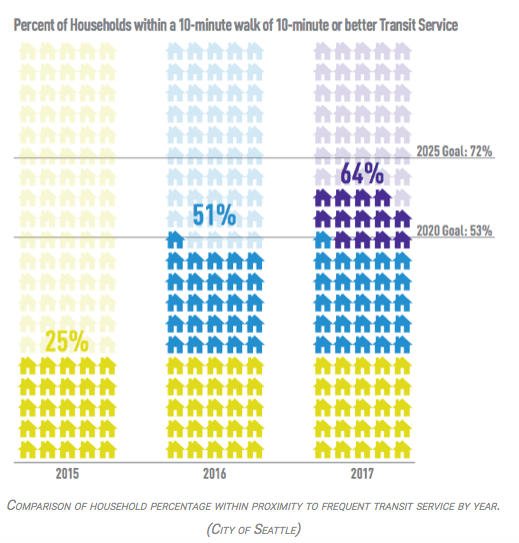In 2014, King County Metro was facing a revenue shortfall, thanks to declining sales tax receipts following the recession.
But unlike other cities, Seattle didn't settle for service cuts, which reduce ridership and lead to further cuts -- the dreaded transit death spiral.
Instead, Seattle voters invested more in transit by adding $60 to vehicle registration fees and increasing the sales tax by 0.1 percent. Not long after, sales tax receipts roared back to life as well. As a result, Seattle was able to improve bus frequency, expand service hours, and offer cheaper fares to young people and riders with low incomes.
The measure was called Prop 1, or the Seattle Transportation Benefit District (STBD). Stephen Fesler at the Urbanist explains how it paid off:
In the first year of the STBD, the city invested the equivalent of 270,000 annual service hours into the Seattle bus system. That was spread across 68 routes, boosting frequency on a lot of routes and restoring others (e.g. Route 47) that had been eliminated. Service hours also went toward reducing crowding at peak times, improving on-time performance, and making routes more frequent when demand is highest. The STBD has put a particular emphasis on some core routes such as the 5, 10, 48, and RapidRide C and D Lines. Annual service hours paid by Seattle now total more than 308,000, an astounding sum that in a number of cases is backing more than 30% of the total service hours for city bus routes.
Transit ridership is seeing healthy growth in Seattle. A significant amount of this has been on frequent transit bus routes and light rail. In fact, bus-based transit has seen some of the largest gains on the RapidRide C, D, and E Lines. The RapidRide C Line, for instance, has experienced a 40% growth in ridership since 2015. This growth was partially induced by 71,000 additional service hours (21% of the new service hours funded by the STBD in 2015-2016) that were showered onto the RapidRide lines during the first year of STBD investments. The net result was more frequency and higher ridership. But another feature of ballooning transit ridership has been led by light rail with more than 100% growth since 2015. Two new stations in Capitol Hill and at the University of Washington are the primary drivers of that.
Without that investment at that key moment, says Fesler, Seattle may not have managed to reduce drive-alone rates to downtown to an all-time low. Seattle is succeeding at the same time other cities have lost ground. Cities like Washington, DC could learn a thing or two from this.






